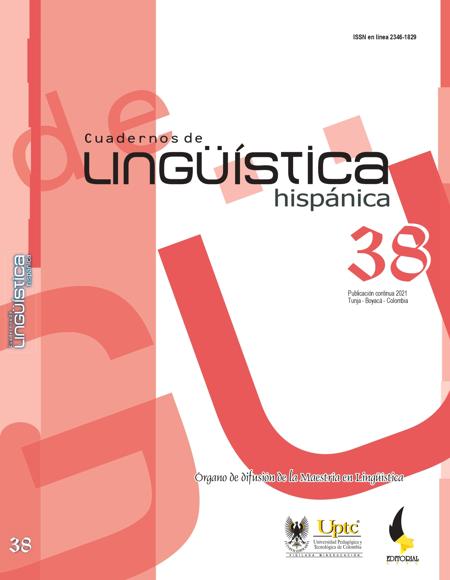How Do We Communicate in Pandemic? Regulation of the Discursiveness and Glotopolitics of COVID-19

Abstract
In this paper, two guidelines published in the context of COVID-19 pandemic
are comparatively analyzed. The objective is to show the ways of the discursiveness regulation and the orientation of those recommendations on language, from a glotopolitical perspective. WHO-PAHO and the Colombian Government were in charge
of these issues aimed at the sectors in charge of managing the health emergency. The analysis combines a lexicometric exploration of lexical associations and concordances
with inductive inferential interpretive procedures. The results show that the change from the discourse of risk to the discourse of harm reorients the regulations on communication towards the discipline of public and private saying. It is concluded that the type of language used by public health institutions replaces the explanations
and analysis required in these circumstances and unifies the points of view through a deeply political discourse that, however, does not seem to be.
Keywords
communication, discourse, pandemic, politics
References
- Arnoux, E. (2015). Los manuales de estilo periodísticos para las versiones on line. Circula, 2, 138-160. https://doi.org/10.17118/11143/7981 DOI: https://doi.org/10.17118/11143/7981
- Arnoux, E. (2016). La perspectiva glotopolítica en el estudio de los instrumentos lingüísticos. Matraga, 23(38), 18-37. https://doi.org/10.12957/matraga.2016.2019 DOI: https://doi.org/10.12957/matraga.2016.20196
- Arnoux, E. (2019). El análisis del discurso como campo académico y práctica interpretativa. En O. Londoño & G. Olave (coords.), Métodos de análisis del discurso (pp. 19-40). Ediciones de la U.
- Arnoux, E. (2020). Prólogo. En M. Cisneros (ed.), Glotopolítica latinoamericana (pp. 5-11). Ediciones UTP.
- Arnoux, E. & Del Valle, J. (2010). Las representaciones ideológicas del lenguaje. Spanish in Context, 7(1), 1-23. DOI: https://doi.org/10.1075/sic.7.1.01nar
- Arnoux, E. & Nothstein, S. (Eds.) (2014). Temas de glotopolítica. Biblos. Beck, U. (2006). La sociedad del riesgo. Paidós.
- Becker, L. (2020). Lenguaje claro/llano/ciudadano y lectura fácil. En S. Greußlich & F. Lebsanft (eds.), El español, lengua pluricéntrica (pp. 125-139). Bonn University Press.
- Castillo-Esparcia, A., Fernández-Souto, A. & Puentes-Rivera, I. (2020). Comunicación política y Covid-19. Estrategias del Gobierno de España, 29(4), e290419. https://doi.org/10.3145/epi.2020.jul.19 DOI: https://doi.org/10.3145/epi.2020.jul.19
- Cendal, F., Lohigorry, J., Marzoaa, C., Quelle, A. & Villalba, N. (2020). La pandemia que puso en agenda de los gobiernos a la salud pública. Red Sociales, 7(02), 12-17.
- Del Valle, J. (2007). La lengua: ¿patria común? Vervuert, Iberoamericana.
- Del Valle, J. (2017). La perspectiva glotopolítica y la normatividad. Anuario de Glotopolítica, 1, 17-40.
- Dorantes y Aguilar, G. (2012). Agenda comunicativa para la implementación exitosa de políticas públicas. Convergencia, 19(59), 117-139.
- Esposito, R. (2020). Curado a ultranza. Dialektika. Dossier Filosofía y Coronavirus. https://dialektika.org/2020/03/17/filosofia-coronavirus-dossier-poderes-delgobierno-la-libertad-individual/#index5
- Garoon, J. & Duggan, P. (2008). Discourses of Disease, Discourses of Disadvantage. Soc
- Sci Med, 67(7), 1133-1142. https://doi.org/10.1016/j.socscimed.2008.06.020 DOI: https://doi.org/10.1016/j.socscimed.2008.06.020
- Gómez, L. (2017). La comunicación de riesgo en salud. Medisan, 21(12), 3386-3399.
- Kirsch, I. S. & Mosenthal, P. B. (1990). Exploring Document Literacy: Variables Underlying the Performance of Young Adults. Reading Research Quarterly, 25(1), 5-30. DOI: https://doi.org/10.2307/747985
- Lasco, G. (2020). Medical Populism and the COVID-19 Pandemic. Global Public
- Health, 15(10), 1417-1429. https://doi.org/10.1080/17441692.2020.1807581 DOI: https://doi.org/10.1080/17441692.2020.1807581
- Llano, N. & Aguila, J. (2020). Conferencias de prensa y COVID-19. Revista Española de Comunicación en Salud, 2020(1), 128-141. https://ojs2017.uc3m.es/index.php/RECS/article/view/5451
- Luhmann, N. (1992). Sociología del riesgo. Universidad de Guadalajara.
- Maingueneau, D. (2014). Discours et Analyse du discours. Armand Colin.
- Majone, G. (1997). Evidencia, argumentación y persuasión en la formulación de políticas. Fondo de Cultura Económica. Nespereira, J. (2014). Los discursos de la pandemia. Cultura, Lenguaje yRepresentación, 13, 185-199. http://dx.doi.org/10.6035/clr.2014.13.10. DOI: https://doi.org/10.6035/CLR.2014.13.10
- Organización Mundial de la Salud & Organización Panamericana de la Salud (2005). Normas de comunicación de brotes epidémicos de la OMS. https://apps.who.int/iris/bitstream/handle/10665/69370/WHO_CDS_2005_28_spa.pdf;jsessionid=EAF5D1A043295A903E7DE59A401ACD04?sequence=1
- Organización Mundial de la Salud & Organización Panamericana de la Salud. (2020). COVID-19: Orientaciones para comunicar sobre la enfermedad por el coronavirus 2019. Guía para líderes. https://www.paho.org/es/ documentos/covid-19-orientaciones-para-comunicar-sobre-enfermedad-porcoronavirus-2019
- Tosi, C. (2018). Escritos para enseñar. Paidós. Vicepresidencia de la República de Colombia, Ministerio de Salud de Colombia & Asociación Colombiana de Facultades de Psicología. (2020). ¿Cómo comunicarnos sin daño durante la pandemia? Comunicadores como vectores de la salud mental. https://mlr.vicepresidencia.gov.co/Paginas/prensa/2020/Como-comunicarnos-sin-dano-durante-la-pandemia-por- COVID-19-Guia-para-comunicadores-y-periodistas.aspx
